Last Sunday we set off for a trek to Choquequirao, a large but only partially excavated Inca site. Having just completed the Inca Trail to Machu Picchu the week before (see our last blog), we inevitably found ourselves comparing the two journeys. In short, our trek to Choquequirao was as fabulous as our trek to Machu Picchu, but in many ways, the two experiences couldn’t have been more different!
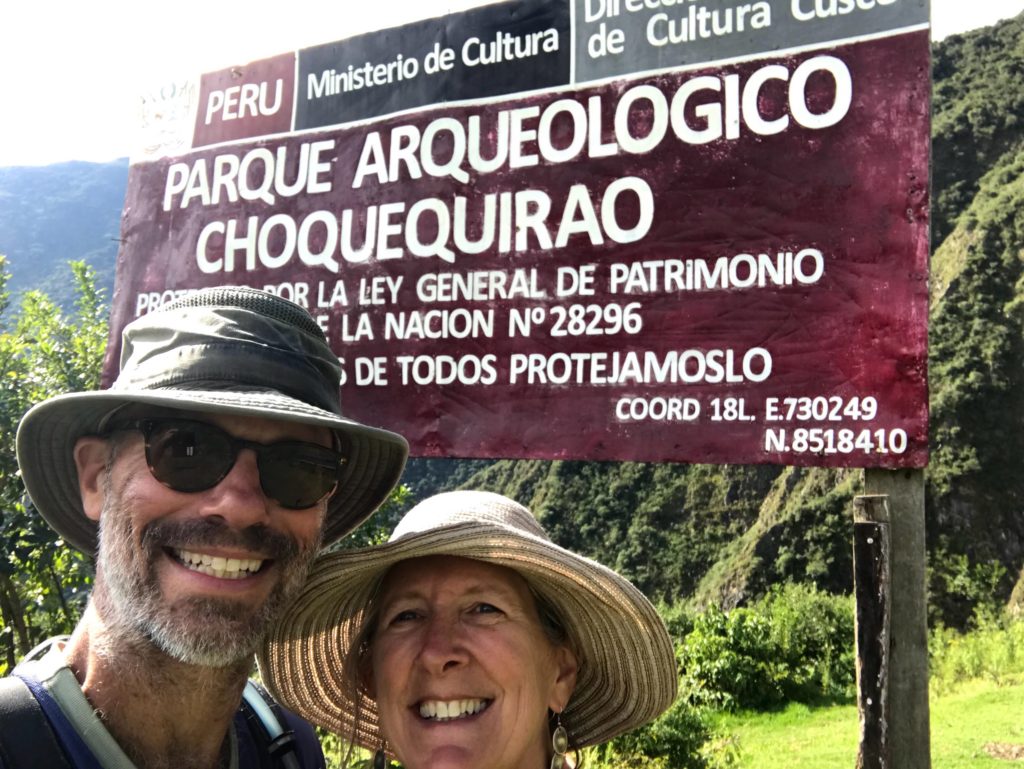
Like Machu Picchu, the Incas built Choquequirao in the mid to late 15th century in a dramatically beautiful setting, surrounded by verdant mountainsides, with high, snow-capped peaks in the distance. Turbulent rivers rush below, and lovely waterfalls abound. There are long panoramic views in several directions and great views of the clouds and the sky.
The Classic Inca Trail starts low, crossing three high passes and then dropping into Machu Picchu. The trail to Choquequirao, in contrast, starts high at 9,500 feet above sea level, drops 4,500 feet to the Apurímac River, then climbs again to 9,500 feet at the site. When you’ve finished your visit, you turn around and go back. To put these numbers in perspective, this is about the same vertical descent and ascent as on the Grand Canyon rim-to-rim hike, but Choquequirao is shorter and steeper–accomplishing that descent and ascent over 13 miles vs. over 24 miles in the Grand Canyon.
Although the Incas did build a trail to Choquequirao (from Machu Picchu), paved with stones and sporting thousands of steps, we approached the site from a different direction, on a dirt trail constructed more recently to serve a few very small rural Andean communities along the trail. This path–suitable only for human feet and mule or horse hooves–is the only way people living in these communities can bring in equipment and supplies. We were amazed to see two men carrying a full-sized refrigerator on the path!
While we did the Inca Trail trek with an organized group, we found ourselves longing for a simpler (and less costly) approach to the Choquequirao trek. So, we decided to go it alone, without a tourist agency, accompanied only by Elisa the mule and her handler Manuel. Elisa never complained about carrying our bags on her back over steep and rugged terrain, and we were so thankful that we had her along for the journey.
You may remember our disappointment at having very little time at the Machu Picchu site itself. We didn’t want to repeat this scenario, so we made sure to give ourselves enough time to really appreciate Choquequirao. We spent the better part of two days at the site, camping overnight in a small adjacent campground. It was a real pleasure to be there, unrushed, uncrowded, and tranquil. On the day we arrived, we counted 13 other visitors at the site. More people arrived the next day, including three full-shebang private tour groups with guides, chefs, and mule handlers, but this still added up to less than 50 people. Compare that with the 1.4 million people who visited to Machu Picchu in 2016!
Choquequirao is larger than Machu Picchu, but that’s hard to tell because only about 30 percent of the area has been freed from the jungle. There are several groupings of buildings, but they are spread out so it doesn’t feel as much like a city as Machu Picchu. It also makes it very difficult to capture in a single photo. The Incas built over a thousand steep terraces at Choquequirao (most of which are still obscured by thick vegetation) stretching almost down to the river and high up the mountain. Just 15 years ago, archaeologists uncovered a set of over 130 terraces on the western slope featuring 24 life-sized inlaid stone llamas and their human herder. These now famous “llama terraces” are unique in the Inca empire. All of the locals we met asked proudly if we had descended to see them.
That was another thing that was different about Choquequirao–the opportunity to talk with people working there or on the trail or living in the nearby villages. The day we visited the llama terraces, a maintenance crew of some 20 workers were diligently cutting back the vegetation that desperately wants to take over again. They spoke with evident pride about what they were doing and pointed out the hundreds of terraces still hidden by the jungle. We met a different crew the next day working on terraces far down the eastern slope. Their task is to cut back the jungle to free and stabilize the terraces, fill cracks between the stones with cement to inhibit the growth of weeds, and plant grass on the flat surfaces where the Incas cultivated corn, coca, and medicinal herbs. These workers aren’t actually rebuilding the terraces. The Incas built them so well, paying such assiduous attention to good footings and proper drainage, that the terraces have survived intact for over 500 years despite being covered in thick vegetation. (Amazing!) It was fascinating to talk with several workers on this crew and to see terraces in all stages of recovery. Such a huge task!
I mentioned communities along the trail. By this I really mean just a few scattered houses and one tiny village, called Marampata, located about an hour’s walk from Choquequirao itself and about 7-8 hours walk from the nearest road. The people who live here grow subsistence crops, raise a few pigs and chickens, and find paid work wherever they can. More recently, the small but steady stream of people hiking to Choquequirao has brought a new source of income. There are several tiny stores selling bottled water and other drinks, food for snacking or cooking, and other basic supplies. Some families offer a flat spot on their property to pitch a tent and access to their toilet and shower for $1.50. A simple hot meal is $2.50.
Increased interest in Choquequirao and further progress in uncovering the site could be a boon to Marampata and San Pedro de Cachora, the much larger village where the driveable road ends and the trailhead begins. While still relatively small, the number of annual visitors has risen over the last 5-10 years. We met a couple of officials from the Peruvian Ministry of Culture who are responsible for promoting Choquequirao as a tourist destination. We heard a lot of talk about future plans to build a cable car across the canyon to allow more people to visit the site, though that’s a bit hard to imagine, and who knows what kind of impact the increased visitation would have on this pristine site. In any case, the people we met worry that Cusco-based tour companies will simply pass them by as they usher the tourists to and from Choquequirao. We ended up spending quite a bit of time in San Pedro de Cachora after our trek, and while a few townspeople are thinking about how to appeal to passing tourists, they lamented that the local government is not thinking strategically about the opportunity. Nor is there a local citizens or business association to step in with the kind of planning and organization that would be necessary to put Cachora on the map. Being there now, we definitely got the sense that we were in a place that is poised on the brink of big changes…and it’s not clear how this will turn out for the local communities, which are quite poor and have few other opportunities. It’s really nice to imagine a future in which they reap the benefits of a Choquequirao success story….
A Sidebar from Lorrie: A Gardener’s Perspective
We both felt a sense of awe and privilege of being present while workers were actively uncovering the history and mysteries of Choquequirao. In visiting Machu Picchu–which is as tidy and well-groomed as a city park–it’s easy to forget what an incredible challenge it would be for the Incas to build and maintain such a place! If you’ve ever worked in a garden, you’ll know what I mean. When we first moved to the Washington, DC area, we rented a little house with a backyard that had been neglected for some years and was completely overgrown with bamboo and other tenacious plants. In my spare time, I decided to clean it up and eventually uncovered a patio and a few terraced steps! But it was a killer to get the bamboo under control and keep that patio in a respectable state.
I kept thinking about my tiny patio experience as we explored Choquequirao, and of my years of efforts in our garden in Bethesda, where the weeds never, ever took a day off. Even with the thousands of workers the Incas conscripted, I can’t even fathom the Herculean effort needed to clear acres of steep-sloped jungle–with lots of bamboo, naturally! And then carving terraces, building stone walls to secure them, planting, and constantly keeping the jungle at bay. It almost seems insane. Now fast forward 500 years, and the jungle is definitely comfortably back in charge while the humans are working slowly and methodically to restore the Inca order. It was fascinating to see the terraces in various stages of recovery and the immense amount of work underway to make them presentable. Nature never rests!




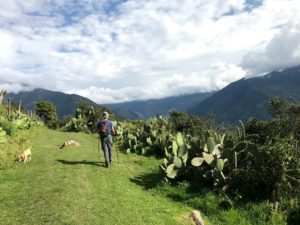





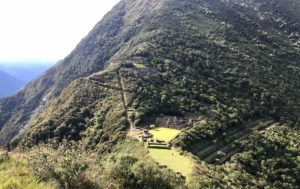

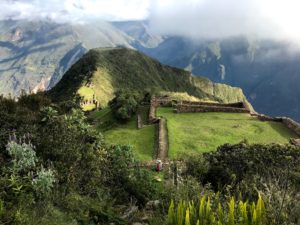

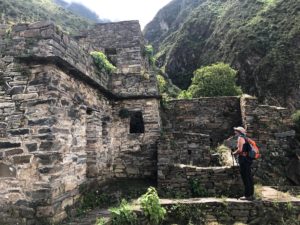

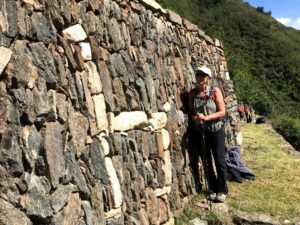
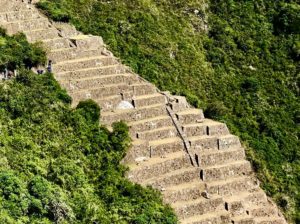
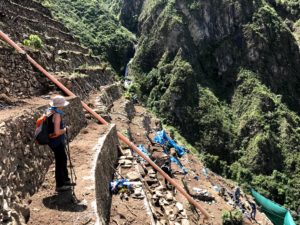
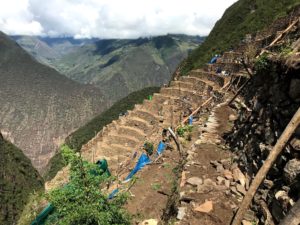






Happy Birthday this week to Lorrie! Really enjoy reading your blogs. Stay healthy! As Randy Newman sang, “It’s a jungle out there!” Brayden is officially 1! Some funny kid! Love,
Your brother Greg and Suzanne
Hey Greg and Suzanne! Thanks for the birthday wishes! I saw pics of Brayden on Facebook this week and he looks so cute! We were so sorry to hear about Pauline…hope all else is well. We’re leaving Cusco today on a wacky bus through the mountains to Ayacucho. Xoxo Lorrie
Fascinating! Your Bethesda garden is bursting into bloom.
Just goes to show that you can’t keep nature down! Best to grow a garden that works with nature instead of trying to tame it.
As Paul Simon would say: I’m glad to see that you’re still crazy after all these years! Tally ho!
Ramon
Wow, what adventures you are having!
And… The Choquequirao trek seems more like the Salkantay approach to Machu Picchu.
Hmmm…Good point. And any way you go, that range of mountains is gorgeous. I intended but forgot to add that it was very hot and buggy at the lower elevations.
Bob and Lorrie, Thanks for sharing another great adventure. See—you’ve got me reading your blogs now! Best wishes for your next adventure.